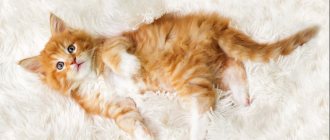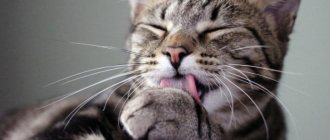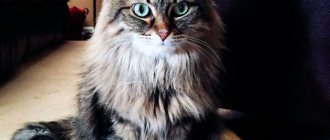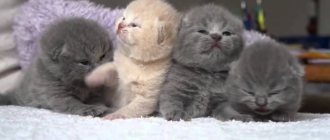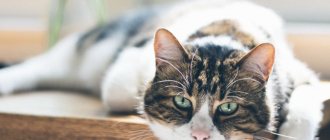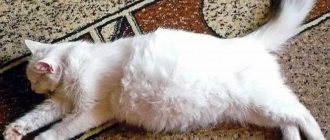How long do cats usually live?
Representatives of small cats in the wild live relatively short lives - 5-6 years . The lifespan of stray cats is approximately the same. Reasons for this:
- poor diet;
- irregular meals;
- invasive diseases;
- infections;
- lack of protection from predators;
- stress associated with the struggle for survival;
- harsh climatic and weather conditions.
The shortest lifespan—4 years—is for cats that, by chance, end up on the street. After a comfortable stay at home, they do not adapt well to the new environment. The fate of neutered cats is even sadder: being unable to compete for a place in the hierarchy, they immediately become outcasts from the pack and do not live more than three years. A little more time—approximately 3.5 years—is given to cats whose bodies are exhausted by constant pregnancies, childbirth, and nursing offspring.
Cats with loving owners have a different fate and life expectancy. Care and attention, human patronage, and the opportunity to receive veterinary care allow them to live 15 years or more.
This is interesting! The oldest cat whose age was confirmed by documents, and not by the words of the owner, was a cat from Devon (Great Britain). She lived 34 years and 5 months.
The absolute champion in survival is the cat Lucy. At the time the record was entered into the Guinness Book (2011), according to the owners, she was 39 years old.
Return to content
Character and behavioral characteristics
Along with the external description, the character of the fold-eared breed also differs from other representatives of the cat world. These are very well-mannered, proud and calm cats. Scottish cats are aristocrats in their origin and behavior. They immediately understand what people want from them and obey them. However, if they don’t like something, they can show their stubborn and unapproachable nature.
Golden chinchilla - a cat with a special character
Sometimes these cats stretch their legs forward and take a strange pose, as if they are meditating. They love to sleep on their backs rather than curled up in a ball. Scots love to have their fur brushed or massaged.
Representatives of the Scottish Fold breed meow very rarely and quietly. They speak only when absolutely necessary and are not used to disturbing others needlessly. Moreover, unlike other representatives of the cat family, fold-eared cats do not impose themselves on their owners asking them to caress and stroke them. They love to be close, but not constantly sit in a person's arms.
Interesting! While still kittens, Folds do not cause much trouble to their owners. However, Scottish kittens love to hide small objects from their owners in corners and secluded places.
Children and other animals
Fold cats are the most loyal and loving. They become very attached and most importantly respect their owners. The breed is famous for its ability to find a common language not only with all representatives and friends of the family in which they live, but also with other pets.
Representatives of this breed get along very well with children. They are attentive to the child and do not fight or scratch. Fold-eared Scots can become the most devoted and well-mannered friends for children for many years.
Scottish Folds are good with children
How long do Scottish Folds live?
The calling card of the breed, the charming fold of the Scottish Fold, arose due to spontaneous mutation and was secured by gene recombination during the selection process. The gene responsible for the anatomical changes in the Scottish auricle also affects the process of formation of all other cartilaginous tissues. Kittens homozygous for this gene have serious defects:
- limited mobility of the joints of the limbs and vertebral joints (osteochondrodysplasia, osteoarthritis);
- skeletal deformities;
- dysfunction of the spinal cord.
Individuals with such anomalies often die before reaching sexual maturity. Another genetically inherited disorder of Scottish Folds is susceptibility to the disease hypertrophic cardiomyopathy. This cardiac pathology quite often causes the sudden death of an animal, regardless of its age.
Scottish fold cats that do not have congenital diseases or anomalies that threaten their health or life, with proper maintenance and care, live on average about 15 years.
Return to content
Relationships with other animals and children
Scottish Folds are obedient, non-hyperactive animals. They treat children warmly, play and communicate with them without letting out their claws. They are indifferent to other people's children who come to visit, but they will humbly allow themselves to be touched and stroked.
Scottish Folds do not conflict with other animals, allowing them to dominate.
There are few conflicts with these pets, and they are rarely considered direct initiators of conflicts. Scottish Fold cats are tactful and forgiving, not subject to impulsive reactions. Behavior that goes beyond the boundaries is observed in them extremely rarely, much less often than in representatives of other breeds.
What affects life expectancy
The main factors that determine a cat's lifespan include:
- heredity;
- conditions of detention;
- quality of diet;
- characteristics inherent in a particular breed;
- availability of veterinary care;
- features of the permanent habitat.
In addition, sterilized pets live several years longer than their counterparts who have preserved their reproductive organs: surgical intervention eliminates the possibility of infection through contact with an infected partner, as well as the development of diseases of the genitourinary system in older cats.
This is interesting! It is believed that outbred cats or those born from mixed marriages live longer and are healthier than their pedigree counterparts, who often pass on genetically determined diseases to their offspring.
The so-called free range, and in fact - unsupervised stay on the street, increases the risk of death of a domestic cat from the aggression of other animals, various injuries, accidents, and dangerous infectious diseases. The life expectancy of a free-roaming cat is much shorter than that of a indoor pet.
Return to content
Education and training
It is necessary to raise a Scottish kitten, taking into account the character and habits of this breed. Raising a pet should be carried out according to two principles:
- instilling cleanliness in the kitten;
- teaching subordination - making it clear that the owner must be obeyed.
The kitten must be toilet trained, sit or lie still when brushing its fur. It is necessary to make it clear that all care activities are necessary for the normal functioning of the pet. The cat must know that sharpening its claws on furniture, climbing on the kitchen table and relieving itself in flower pots is prohibited.
Important! If your pet copes with the assigned tasks, you should definitely praise him and reward him with treats.
It is necessary to train a cat when the pet is interested in communicating with the owner. To develop the reflex, you need to give commands before feeding or walking the cat. Simple commands like “Ugh!” or “You can’t!” it needs to be repeated as necessary so that the cat knows what can and cannot be done.
How to increase the lifespan of a Scotsman
Thanks to many advances in veterinary medicine and the development of the pet business, the lives of pets have become much longer and more comfortable . To ensure that 15 years is not the limit for the life expectancy of a Scottish Fold, its owner must be responsible, starting with the choice of a kitten and throughout the pet’s life.
- You should only purchase a fold-eared baby from a conscientious, reputable breeder or at a cat show. This solution minimizes the risk of purchasing a sick animal.
- Particular attention should be paid to issues of maintenance and care.
- Even before the furry newcomer appears in the house, you need to decide on the type of food he will eat, whether it will be factory-made food or natural products. When choosing ready-made food, preference is usually given to the “super-premium” and “holistic” classes: these lines take into account the age, breed and individual characteristics of cats.
- A natural diet should be balanced, varied, meeting the needs of carnivores in general and Scottish Folds in particular: contain not only all nutrients, but also taurine, which Scottish cats, like all other cats, do not produce on their own.
Important! The process of digestion and fermentation of food in a cat’s gastrointestinal tract depends on the type of food. Mixing canned and natural products in one serving is unacceptable, as it leads to disorders of the pancreas and intestines.
- Routine and preventive examinations by a veterinarian are required, as well as timely vaccinations against rabies, panleukopenia, chlamydia, calcevirosis, and rhinotracheitis.
- Given the propensity of the Scottish population for cardiomyopathy and the difficulty in diagnosing this disease, ultrasound of the heart and chest should be included in the examination.
- Monitoring the condition of the gums and teeth must be constant: dental problems lead to diseases of the digestive system.
- If breeding a breed is not the purpose of purchasing an animal, it is advisable to sterilize it in due time.
- Regardless of whether the Scottish Fold is outdoors or in contact with other animals, periodic anti-parasitic measures are required.
- To maintain muscle tone and good shape, your pet needs to be provided with physical activity through games and training.
Such careful care and sincere love will allow the Scottish Fold to live to the respectable age of twenty.
Return to content
Interesting information about the representatives of the breed
Highland fold (Scottish fold longhair cat)
Scottish cats have not only an unusual appearance, but also a special behavior. They can often stand on their hind legs for a long time, which they do not to attract attention to themselves, but to stretch their spine. Fold-eared pets are also afraid of heights, so they do not climb onto cabinets and curtains.
Some representatives of the breed sometimes have erect ears, so they are confused with another Scottish Straight breed. This can lead to unpleasant consequences, as inexperienced owners often mix straight-eared folds with straights, and sick mixed-breed kittens are born.
Pros and cons of the breed
Scottish Folds are ideal pets; they are smart, well-mannered, loyal, friendly and calm. But most often, it is the appearance of the “teddy bear” that attracts attention when choosing a breed. But it is still worth paying attention to several disadvantages of this type of cat.
Advantages of the Scottish Fold breed:
- exceptional aristocratic character;
- beautiful plush appearance;
- loyalty and non-intrusiveness towards the owner;
- cleanliness and good manners;
- get along well with small children, do not offend or attack them;
- are calm friends with other pets;
- quickly adapt to new conditions and terrain;
- do not require constant and special care;
- sometimes folds behave strangely and funnyly, take funny and strange poses.
Disadvantages of fold-eared cats:
- due to the structure of the ears characteristic of the breed, cleaning them from accumulated wax is very difficult;
- very high cost when compared with other cat breeds;
- Due to gene mutations in the body, cats can have congenital diseases: osteochondrodystrophy and hemophilia.
Important! In addition to bone deformation and blood clotting disorders, Scottish Folds can have problems with the functioning and structure of internal organs. Therefore, it is necessary to visit the veterinarian regularly.
Kittens must be selected according to certain criteria
Standards
The weight of a Scottish Straight individual is 3-3.5 kg, rarely more.
| Standard | Description |
| Head | The shape of the skull is round, with convex cheeks and forehead. The cheekbones are clearly defined (more so in cats than in cats), the chin is strong. The whisker pads are oval and plump. The nose is short, with a wide bridge and no noticeable stop. |
| Eyes | Large, widely spaced. The iris can be any color. |
| Ears | Large, wide at the base and with rounded tips. The outside is abundantly pubescent, the inside is less, but lush panicles, hard and long, grow on the skin. |
| Torso | Muscular, long, large, but with soft smooth lines. The neck is muscular and short. |
| Limbs | Long, strong, with oval and elastic legs. |
| Tail | Long, dense, reaching the shoulder blades in length. |
| Wool | The coat is thick, dense, and plush to the touch. It can be either short or medium length. Undercoat is present. |
Serious defects are considered:
Read also: Bankruptcy of Nokia
- turned out toes;
- cryptorchidism;
- creases on the tail;
- short tail;
- small eyes;
- explicit “stop”;
- flat forehead;
- too wide ears.
Care and maintenance
Scottish Straights are typical domestic cats for whom walks in the fresh air are pleasant entertainment, but not more than that. This is why Scots are considered ideal pets for homebodies. In everyday life, straights are unpretentious and rarely cause trouble. Take your animal for routine veterinary examinations, carry out timely vaccinations, use high-quality food - and straight-eared Scottish cats will not create any problems for you.
Hygiene
Scottish Straight loves its owner
Scottish Straight cats are very clean cats that carefully monitor the condition of their own fur, but they still need to be bathed from time to time. Usually, cats are washed as their “coat” gets dirty, using shampoo from the pharmacy. At the end of the procedure, you can apply a balm to the coat. When bathing, make sure that water does not get into the animal’s ears and be sure to protect the wet pet from drafts.
Owners of show-class specimens preparing to participate in exhibitions will have to work a little harder. In particular, a few months before the event, the cat begins to be washed daily to completely remove dead cells from its skin and stimulate the growth of new fur. In addition, you will have to spend money on a variety of professional coat care products, ranging from degreasing paste to texturizing conditioner. Brush Scottish cats once a week with a short hair brush. Claws are trimmed as they grow. Be sure to monitor the condition of your cat's eyes and remove unwanted discharge with a swab soaked in hygiene lotion.
Feeding
The diet of Scottish Straights is no different from the “menu” of their fold-eared counterparts. Just like folds, Scottish straight-eared cats benefit from lean meat, offal, boiled sea fish, fermented milk products, and egg yolk. In addition, the animal’s diet should include vegetables (raw or stewed), cereals and sprouted wheat.
Prohibited
- Fat meat.
- Beans and potatoes.
- Bones.
- Sweets, spices, smoked foods.
- Garlic and onion.
- Bread.
- River fish.
- Citrus.
- Mushrooms.
- Raw eggs.
Curious Scottish Straight
In serious nurseries, Scottish Straight kittens are sold starting from the age of three months. During this period of life, the baby no longer feeds on mother's milk, which means it is able to eat the same food as an adult animal.
An important point: natural-fed straight cats do not receive enough of the vital microelements. Vitamin and mineral complexes, which can be purchased at a veterinary pharmacy, solve this problem.
Scottish Fold cats can also be fed commercial food if you are willing to spend money on its non-budget varieties - “premium”, “super premium” and “holistic”. An ideal cut for a Scottish dog should contain at least 26% protein and about 9% fat. It is advisable that the food does not contain wheat and corn, which can cause allergies in the cat. From this point of view, the most useful options for “drying” can be considered the Canadian Acana Pacifica Cat and the American Earthborn Holistic.
Three-month-old Scots are fed up to 6 times a day, six-month-old kittens eat 5 times a day, nine-month-old kittens - 4 times. One-year-old individuals are considered adults, so 2-3 meals are enough for them.
Health
Scottish cats have a genetic defect. It was he who led to such a feature of their ears. Due to the presence of this gene, they are also predisposed to diseases of the musculoskeletal system and joints. Scottish cats often develop osteochondrodysplasia. This disease is characterized by curvature of the spine and limbs, impaired mobility of the tail. This pathology cannot be treated and is what most often causes a reduction in the life expectancy of Scottish cats. These animals are also prone to ear diseases. They often get ear mites and inflammation develops. It is necessary to regularly take your pet to the veterinarian and vaccinate it. With proper care and following all doctor's recommendations, a Scottish cat can live about 20 years.
Author: Oskina Oksana Valentinovna
Proper nutrition and diet
A balanced diet is the key to health. Consult with a specialist to choose the right food for your cat. Good food contains all the necessary vitamins and you do not have to purchase additional vitamins. The food can treat some diseases common to cats of this breed. Don't experiment with Scotch's diet. After all, it directly affects the health of the pet. It is preferable to feed cats with high-quality food. Under no circumstances should natural food be mixed with feed. This is stressful for any cat's digestive system.
Scottishfold care
Like other pets, Scottish cats require regular and proper care. The eyes of fold-eared cats need to be examined; they need to be cleaned with a cotton pad as they become dirty. Fold does not have the habit of damaging furniture with his claws, but for the safety of the cat itself, it is necessary to trim its claws when they grow back.
Fold cats are usually bathed 2 times a month; in winter, once a month is sufficient. But the fur needs to be combed more often to prevent the formation of tangles. The wool is combed first in the direction, then against the growth.
Additional Information! The Scottish cat is not distinguished by a capricious and pugnacious disposition, so the procedure for combing its fur is carried out without problems. Moreover, four-legged friends love this event and will lie quietly, perhaps purring with pleasure.
What you need to know about Scottish Fold ears
Scottish Fold kittens are born with straight ears. Only in the process of growth, in the third or fourth week from birth, do their ears begin to fall and take the form of a bend or crease characteristic of the breed.
It is necessary to examine the animal’s ears at least twice a month. You just need to carry out the procedure carefully so as not to cause pain or damage your pet’s unusually shaped ears.
Note! Rarely do Scottish Folds have ears that “stand up” as they grow. In such cases, it becomes impossible to distinguish them from another similar Scottish Straight breed.
Life expectancy of Scots
The immunity of these cats is excellent, and there are only two difficulties that darken the lives of the owners:
- ear diseases;
- ailments of the skeleton and skeletal system in general.
In most cases, these diseases are not fatal, but they can seriously ruin the life of a furry pet, and in the worst case scenario, they have a negative impact on life expectancy. It is precisely because of this that future owners are advised to carefully study the babies before taking them home.
Many people, having become aware of such difficulties, realize that they do not have the opportunity to expend energy on a sick animal, which, most likely, will not live long, so they stop caring for it altogether. It is advisable to think about this in advance and choose a full-fledged animal that can stay with its owners for many years and will be a member of the family.
So how can you be sure that the lifespan of a particular Scottish Fold will not be shortened by all sorts of annoying ailments mentioned above?
This is not difficult - before deciding on the choice of a kitten from the previous owner, you should carefully examine its limbs and tail. If they are quite mobile, bend as expected, and the baby does not scream, then everything is fine.
And if you are persuaded to buy a kitten with an inert and suspiciously small tail, then you need to worry - it is probably susceptible to all the diseases characteristic of Scottish Folds, which means, ultimately, the presence of a defective pet that is unlikely to last as long as a full-fledged individual.
Another circumstance that can undermine the health of a fold-eared cat is grooming. And this is not a joke at all. Those who have pets with long hair really need to comb their fur regularly so that matted hair does not form there.
If you take too long with combing, then complete cutting may not help, and the unfortunate individual will suffer from terrible pellets that will become excessively difficult to move. Physical inactivity will lead to irreversible changes in the body, which, naturally, cannot go unnoticed and will not affect the cat’s lifespan.
So those who want their Scottish Fold to live with him for many years, to be cheerful, healthy and playful, should take care of his future in advance. It is necessary to undergo an examination of the skeletal system and try to ensure that the pet lives the 15-20 years it is supposed to.



